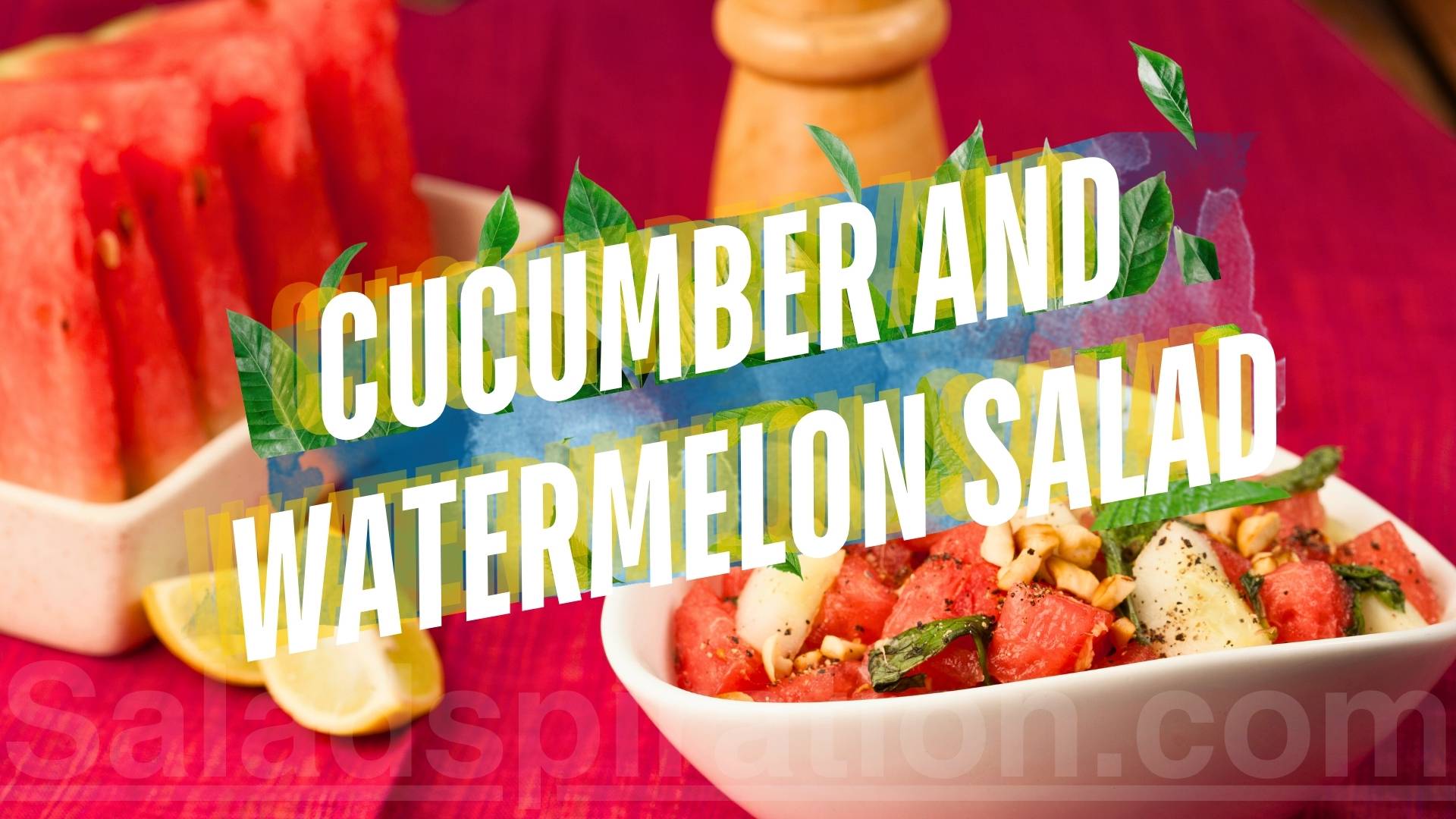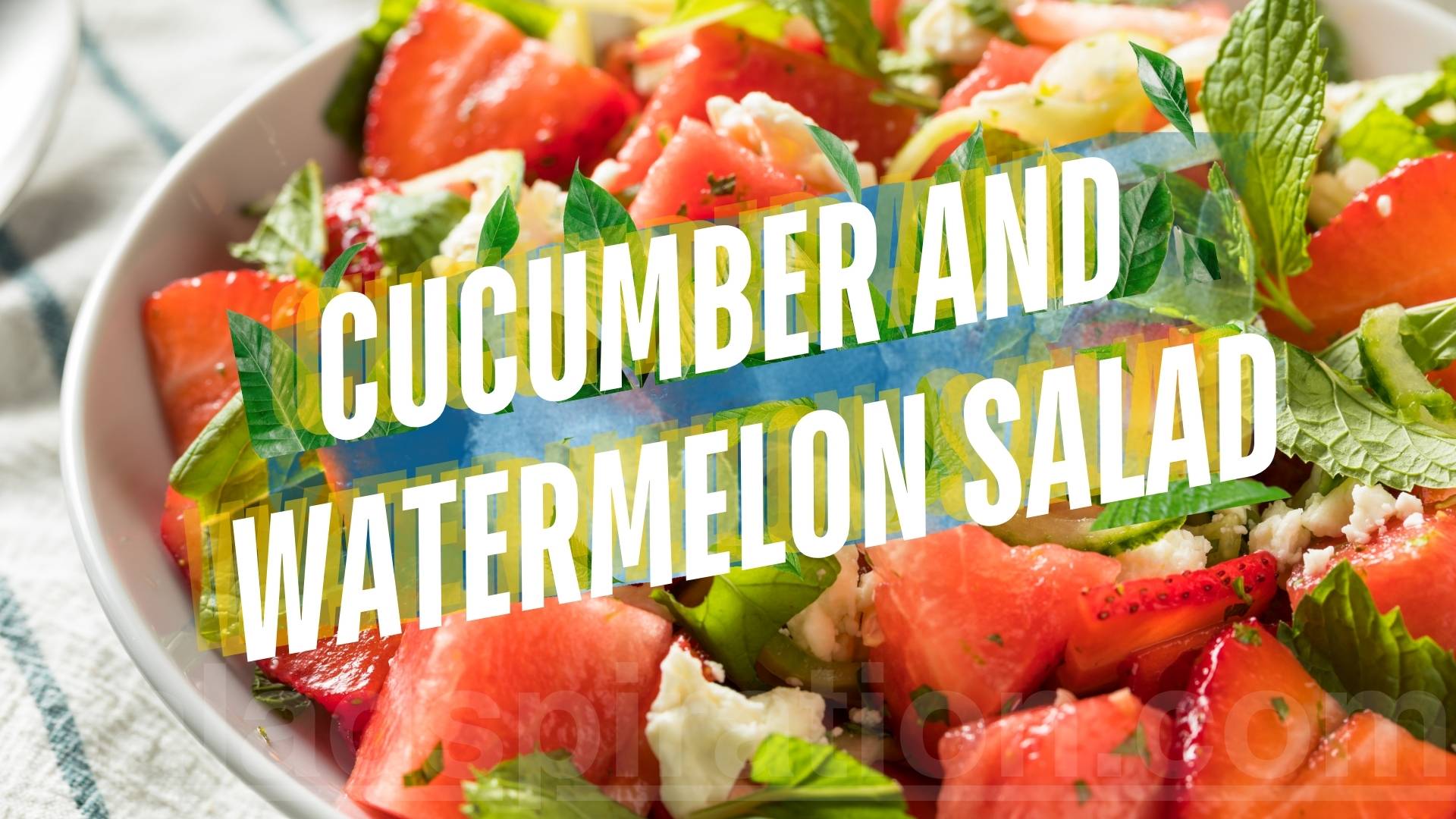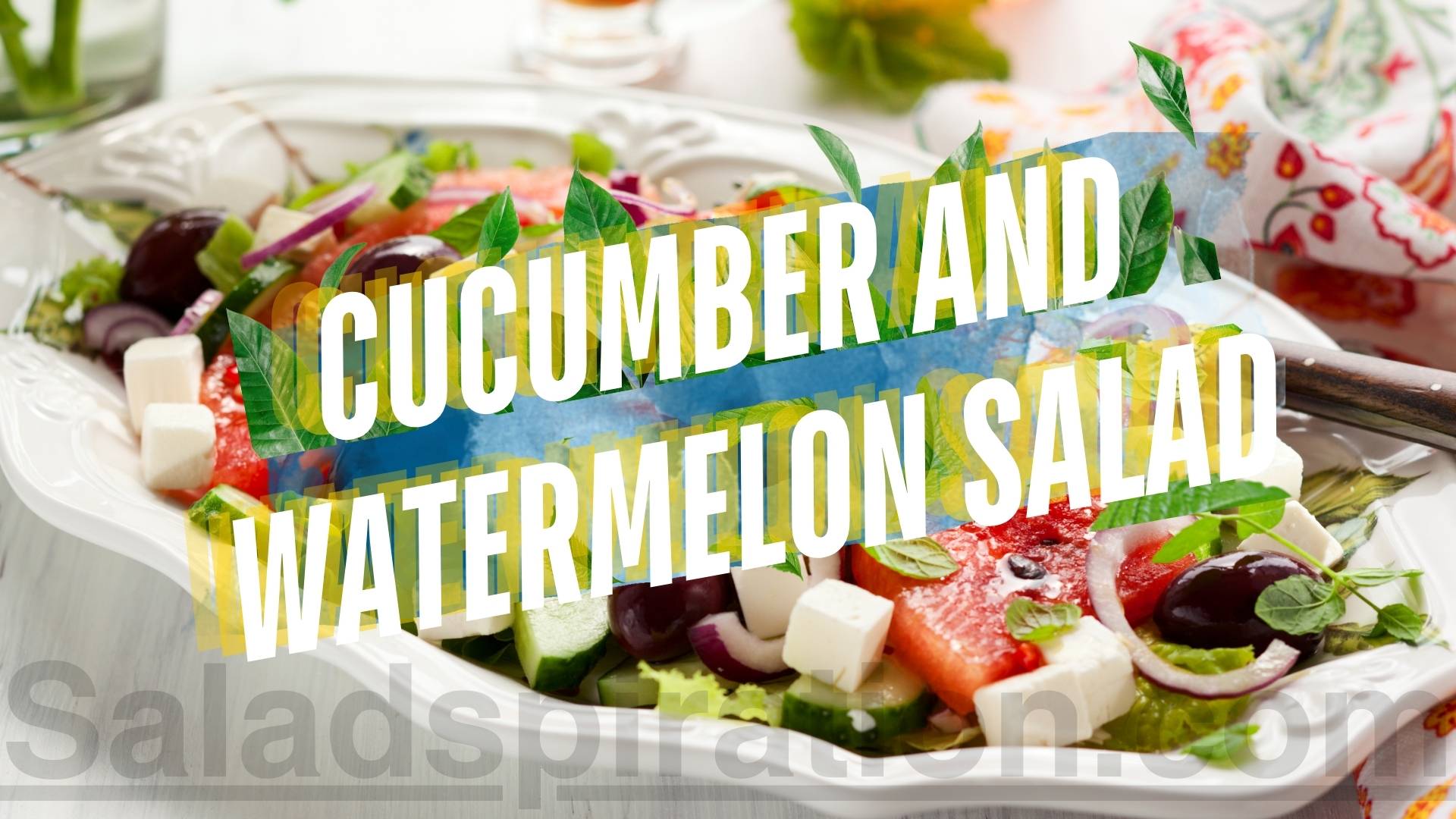This Cucumber and Watermelon Salad is a celebration of summer’s juiciest and most refreshing flavors. It’s a vibrant and hydrating salad that’s as beautiful as it is delicious. Sweet watermelon cubes and cool cucumber slices mingle with a hint of tangy lime and salty feta, creating a symphony of textures and tastes that’s perfect for a hot day, a light lunch, or a delightful side dish.
–

–
Why You’ll Love This Salad:
-
Hydrating and Refreshing: This salad is bursting with juicy watermelon and crisp cucumbers, making it incredibly hydrating and refreshing, especially on warm days.
-
Sweet and Savory Balance: The sweetness of the watermelon is perfectly balanced by the cool cucumbers, tangy lime dressing, and salty feta cheese, creating a harmonious flavor profile that’s both satisfying and refreshing.
-
Easy to Make: This recipe comes together in minutes, requiring minimal chopping and no cooking. It’s perfect for busy days or when you need a last-minute side dish.
-
Versatile and Colorful: This salad is a beautiful and colorful addition to any table. It pairs well with a wide variety of main courses, from grilled meats and fish to spicy dishes and sandwiches.
–
Instructions:
-
Prepare the watermelon and cucumbers: Pat the watermelon cubes dry with a paper towel to remove excess moisture. Wash the cucumbers thoroughly and pat them dry. For a milder flavor and appealing color contrast, consider peeling every other stripe of cucumber skin. Slice the cucumbers thinly using a mandoline or a sharp knife.
-
Create the lime dressing: In a small bowl, whisk together the lime juice, olive oil, honey, salt, and black pepper. This simple vinaigrette adds a bright and tangy element that complements the sweetness of the watermelon and cucumbers beautifully.
-
Combine and chill: In a large bowl, combine the watermelon cubes, cucumber slices, and crumbled feta cheese. Drizzle the dressing over the salad and gently toss to ensure everything is evenly coated.
-
Rest and serve: For optimal flavor, cover the salad and refrigerate for at least 30 minutes before serving. This allows the flavors to meld and the watermelon and cucumbers to soak up the delicious dressing.
–
Ingredients:
-
4 cups cubed watermelon, seeds removed
-
2 medium cucumbers
-
1/2 cup crumbled feta cheese
-
For the dressing:
-
2 tablespoons lime juice
-
1 tablespoon olive oil
-
1 teaspoon honey
-
1/4 teaspoon salt
-
1/8 teaspoon black pepper
-
–
Recipe Note: This salad is best served fresh, as the watermelon tends to release water over time. Feel free to adjust the amount of lime juice and honey to your liking. You can also add other fresh herbs like mint or basil for an extra layer of flavor.
–
#cucumberandwatermelonsalad #cucumber #saladspiration
–
Watermelon: A Refreshing Slice of Health
–

–
Watermelon, with its vibrant color and juicy sweetness, is more than just a summer treat. This beloved fruit, scientifically known as Citrullus lanatus, is a powerhouse of nutrients, offering an array of health benefits. Packed with vitamins, minerals, antioxidants, and other bioactive compounds, watermelon holds a prominent position in promoting overall well-being. Let’s delve into the science behind watermelon’s health-promoting properties and uncover why this delicious fruit deserves a prominent place in your diet.
–
Lycopene: The Red Pigment with a Powerful Punch
–
One of the most remarkable compounds in watermelon is lycopene, the natural pigment responsible for its vibrant red hue. Found abundantly in watermelon, lycopene is a potent antioxidant that plays a crucial role in neutralizing harmful free radicals in the body. These free radicals are unstable molecules that contribute to oxidative stress, a process linked to chronic diseases such as heart disease, cancer, and neurodegenerative disorders.
–
Numerous studies highlight lycopene’s efficacy in combating oxidative stress and its related health risks. For instance, research published in the journal Nutrients found that lycopene intake was associated with a reduced risk of cardiovascular disease. The study suggested that lycopene’s antioxidant action helps protect blood vessels from damage caused by free radicals, thereby improving heart health.
–
Moreover, lycopene has shown promising results in cancer prevention. A review published in the journal Cancers concluded that lycopene exhibits anti-tumor activity, particularly against prostate, lung, and breast cancers. The review emphasized lycopene’s ability to inhibit tumor cell growth and proliferation, suggesting its potential role in cancer management.
–
What sets watermelon apart is its exceptional lycopene content. In fact, it surpasses tomatoes, which are often touted as the gold standard for lycopene, in its concentration of this valuable antioxidant. One cup of diced watermelon provides approximately 12 milligrams of lycopene, exceeding the amount found in a similar serving of raw tomato.
–
Moreover, the bioavailability of lycopene in watermelon, meaning the amount readily absorbed and utilized by the body, is higher than that of tomatoes. This superior bioavailability makes watermelon an excellent dietary source for maximizing lycopene’s health benefits.
–
Vitamins, Minerals, and More: The Nutritional Bounty of Watermelon
–
Beyond lycopene, watermelon delivers an impressive array of essential vitamins and minerals, each contributing to its health-promoting qualities:
-
Vitamin C: This essential vitamin is a powerhouse of antioxidant activity, bolstering immune function and promoting healthy skin. Vitamin C plays a vital role in collagen synthesis, a protein essential for maintaining skin elasticity and wound healing. Studies suggest that adequate vitamin C intake contributes to a reduced risk of chronic diseases like heart disease and certain cancers.
-
Vitamin A: Crucial for maintaining healthy vision, vitamin A also supports cell growth and differentiation, ensuring the proper functioning of organs like the heart, lungs, and kidneys. Additionally, vitamin A contributes to a robust immune system, defending the body against infections.
-
Potassium: This essential mineral plays a vital role in regulating blood pressure, a key factor in maintaining cardiovascular health. Potassium helps counteract the effects of sodium, a common culprit in elevating blood pressure. Maintaining adequate potassium intake supports healthy blood pressure levels and reduces the risk of stroke and heart disease.
-
Magnesium: Involved in over 300 biochemical reactions in the body, magnesium is crucial for muscle and nerve function, blood sugar control, and blood pressure regulation. This mineral also contributes to maintaining bone health and a healthy immune system. Its role in energy production makes it essential for combating fatigue and maintaining optimal energy levels.
–
Hydration Hero: Watermelon Quenches Thirst and More
–

–
Watermelon’s high water content, approximately 92%, earns it its name and makes it a potent natural hydrator. This high water content, along with its rich electrolyte profile, makes it an excellent choice for replenishing fluids lost through sweat, especially during the hot summer months or after physical activity.
–
Adequate hydration is essential for maintaining various bodily functions, including:
-
Regulating Body Temperature: Water plays a vital role in thermoregulation, helping the body maintain a stable internal temperature. When body temperature rises, sweating helps dissipate heat, and watermelon’s high water content assists in replenishing fluids lost through perspiration.
-
Transporting Nutrients: Water acts as a solvent, aiding in the transport of nutrients and oxygen to cells throughout the body. Proper hydration ensures efficient nutrient delivery, optimizing cellular function and overall health.
-
Lubricating Joints: Water acts as a lubricant for joints, reducing friction and cushioning impact during movement. Maintaining adequate hydration contributes to joint health and may help prevent age-related joint issues.
-
Flushing out Waste Products: Water aids in digestion, dissolving nutrients and fiber and facilitating smooth bowel movements. Adequate hydration is essential for preventing constipation and ensuring regular waste elimination.
–
Dehydration, on the other hand, can lead to fatigue, constipation, kidney stones, and heat stroke. Watermelon’s impressive water content, coupled with essential electrolytes like potassium and magnesium, helps replenish lost electrolytes, aiding in faster rehydration and preventing these complications.
–
Citrulline and Cucurbitacin E: Natural Allies for Muscle Recovery
–
Beyond its hydration prowess, watermelon holds particular interest for athletes and fitness enthusiasts due to the presence of citrulline and cucurbitacin E.
Citrulline, an amino acid abundant in watermelon, exhibits promising effects in enhancing athletic performance and promoting muscle recovery. The body converts citrulline to arginine, another amino acid crucial for nitric oxide production. Nitric oxide (NO) is a vasodilator, meaning it helps relax blood vessels, improving blood flow and delivering oxygen and nutrients more efficiently to muscles during exercise.
Research supports the beneficial role of citrulline supplementation in improving exercise performance. A study published in the Journal of Strength and Conditioning Research found that citrulline malate supplementation increased the number of repetitions participants could perform during a weightlifting exercise and reduced muscle soreness. Another study in the Journal of the International Society of Sports Nutrition concluded that watermelon juice supplementation improved athletic performance and reduced muscle soreness in athletes.
Furthermore, watermelon contains cucurbitacin E, another bioactive compound with potential anti-inflammatory and analgesic (pain-relieving) properties. While research on cucurbitacin E’s specific effects on muscle recovery is still in its early stages, preliminary studies suggest that it may help alleviate muscle soreness and promote healing after exercise.
–
Choosing and Storing Your Watermelon: Tips for Optimal Freshness and Flavor
–
Selecting a ripe and flavorful watermelon can enhance your culinary experience. Here are some helpful tips:
-
Look for a dull rind: A shiny rind indicates that the watermelon might not be fully ripe. Opt for a watermelon with a more matte or dull appearance, signaling ripeness.
-
Check the field spot: The underside of a watermelon has a yellow spot called the field spot. This spot should be creamy yellow or even a buttery yellow color, indicating it spent ample time ripening on the vine. A white or pale yellow field spot might indicate it was picked too early.
-
Give it a thump: While not foolproof, a ripe watermelon should have a deep, hollow sound when you thump it with your knuckles. This indicates a juicy and ripe interior.
–
Once you’ve selected your perfect watermelon, proper storage is key to maintaining its freshness and flavor:
-
Whole watermelons: Uncut watermelons can be stored at room temperature until you’re ready to use them. Once cut, wrap the remaining watermelon tightly in plastic wrap or store it in an airtight container in the refrigerator for up to 3-4 days.
-
Cut watermelon: Diced or cubed watermelon can also be stored in an airtight container in the refrigerator for up to 3-4 days.
–
Conclusion
–
Watermelon, beyond its refreshing taste and ability to quench your thirst on a warm day, offers an impressive array of health-promoting properties. This nutrient-dense fruit, with its rich antioxidant profile, particularly its high lycopene content, provides a refreshing path towards reducing the risk of chronic diseases, including heart disease, stroke, and certain cancers.
–
Its abundant water content, along with essential electrolytes, makes it a natural hydrator, promoting optimal bodily functions. For athletes, watermelon’s unique blend of citrulline and cucurbitacin E holds promise in enhancing exercise performance and aiding muscle recovery.
–
From promoting heart health and reducing cancer risk to boosting hydration and aiding athletes, watermelon proves to be a versatile fruit, easily incorporated into a healthy and balanced diet. Whether enjoyed fresh, in a salad, or blended into a refreshing smoothie, this nutrient-packed fruit deserves a prominent place at your table, providing a delicious and refreshing way to prioritize your well-being.
–
–
Leave a reply
















